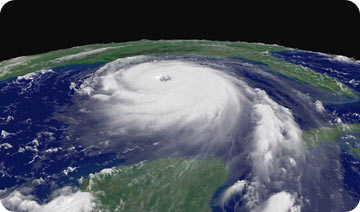The deadliest hurricane in U.S. history slammed into Galveston, Texas, on September 8th, 1900. It killed an estimated 8,000 people. Despite its infamy, though, there’s no formal name for the hurricane. At the time, there was no procedure for naming such storms.
 view of Hurricane Katrina taken on Aug. 28, 2005, when the storm was a Category Five hurricane. Credit: National Oceanic and Atmospheric Administration
view of Hurricane Katrina taken on Aug. 28, 2005, when the storm was a Category Five hurricane. Credit: National Oceanic and Atmospheric AdministrationThat’s not a problem today. The names of hurricanes and tropical storms in the Atlantic Ocean and Gulf of Mexico are selected years in advance. In fact, except for the names of particularly deadly storms, like Andrew and Katrina, the names repeat every six years, so the list is basically set for decades to come.
Until World War II, most tropical systems were given names only in the areas in which they hit land. In the West Indies, for example, a storm was named for the saint on whose day it made landfall.
After the war, the United States briefly named storms with the military alphabet -- Abel, Baker, Charlie, and so on. But in 1953, it began bestowing the names of women; the first was Tropical Storm Alice. In 1979, the practice was changed to alternate the names of women and men; the first male name was Bob.
Today, the list of names is maintained by an international body. It includes 21 names for each year, using every letter of the alphabet except Q, U, X, Y, and Z.
For 2011, the list of names begins with Arlene and Bret and ends with Vince and Whitney. And if that’s not enough, then additional storms will be designated with the letters of the Greek alphabet. That makes sure that every big tropical storm has a name.

